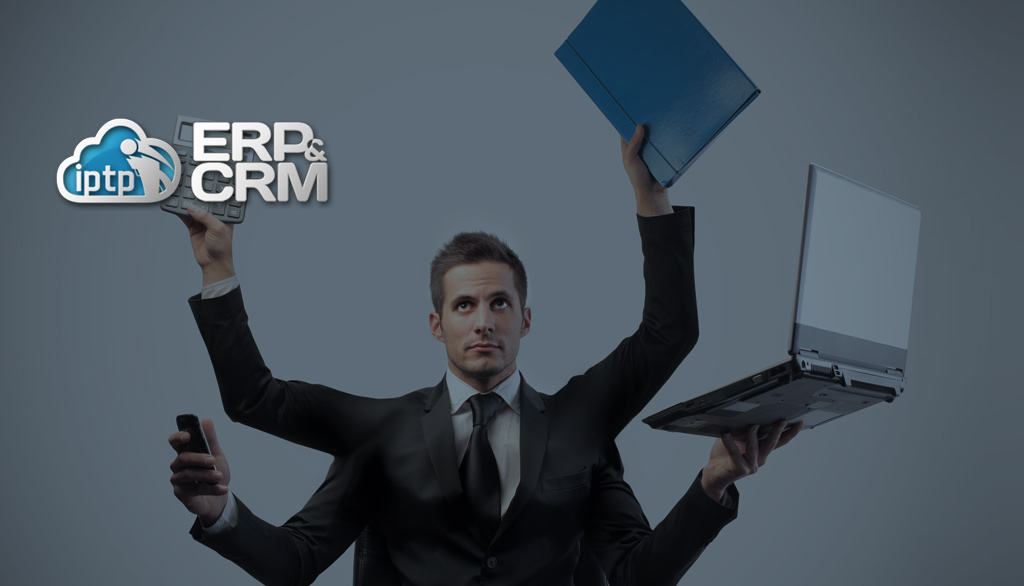IPTP XRM (ERP+CRM)

One unified and complete
solution to drive productivity
- FINANCE
- SUPPLY CHAIN
- HUMAN RESOURCES
- CUSTOMER RELATIONSHIP MANAGEMENT
- MANUFACTURING
- BUSINESS INTELLIGENCE
- PROJECT MANAGEMENT
IPTP XRM(ERP+CRM) is an all-in-one cloud business management solution that makes it easier for companies to run more efficiently by automating key business operations and providing a real-time holistic view of operational and financial performance.
It fully automates main business processes, cutting costs significantly, systematizing work tasks and marginalizing human error.
Deployment via SaaS allows you to avoid the additional costs involved in purchasing appropriate
equipment, providing the most cost-effective way of supporting your corporate activities.
Easy to deploy and seamlessly integrated with professional services tailored to your needs while maintaining the flexibility you need to grow.
XRM(ERP+CRM) system include the following components:
FINANCE
KEY FEATURES:
- General Ledger
- Automatic Billing
- Billing & Invoicing
- Expense Tracking
- Multi-Company
- Multi-Currency
- Financial Reports
- Trial Balance
- Turnover balance
- Aging of Receivables
SUPPLY
CHAIN
KEY FEATURES:
- Inventory Management
- Item Management
- Multi-Location
- Order Tracking
- Shipping Management
- Pricing Analysis
HUMAN
RESOURCES
KEY FEATURES:
- Employee Management
- PAEI classification
- Payroll Management
- Work/Duty Time Planning and Scheduling
CUSTOMER RELATIONSHIP
MANAGEMENT (CRM)
KEY FEATURES:
- Marketing Campaigns
- Global Contacts Database
- Lead And Opportunity Management
- Sales Orders
- Lead Conversion Reports
- Sales Pipeline
MANUFACTURING
KEY FEATURES:
- Bills of Material
- Assembling with Template Inheritance
- Fixed Asset Management
- Manufacturing Inventory Management
BUSINESS
INTELLIGENCE
KEY FEATURES:
- Financial Analysis
- Forecasting
- Revenue Distribution Management
- Growth Projecion YoY
- Data Visualisation
PROJECT
MANAGEMENT
KEY FEATURES:
- Activity Tracking
- Interaction Tracking
- Task Management
- Task Progress Tracking
- Project Accounting
GENERAL PURPOSE FEATURES AND CORE FUNCTIONALITY
- Alerts/Notifications
- Audit Trail
- Document Generation, Management and Storage
- Email Templates
- Data Import/Export Management
- Live Assistance Integration
- Secure Data Storage
- Workflow Management
ADMINISTRATIVE TOOLS
The system administrative tools allow you to create your own objects in the ERP/CRM system, based on existing templates or particular data structure in the database. You can create such objects as Dictionaries, Documents, Journals, Reports and Registries, manage their properties and references, include specific localisation extension.
Create your own company role model through administrative tools and control user access to certain components, actions and data according to specific classifiers.
Using ERP SDK you can implement your own functionality to solve business problems, as well as implement integration with any third-party products.
COMPARE
| Microsoft 365 | SAP Business One | IPTP XRM(ERP+CRM) | |
|---|---|---|---|
| Alerts/Notifications | |||
| Archiving & Retention | |||
| Audit Trail | |||
| Barcoding/RFID | |||
| Cataloging/Categorization | |||
| Customizable Templates | |||
| Data Synchronization | |||
| Document Automation | |||
| Document Capture | |||
| Document Generation | |||
| Document Management | |||
| Document Storage | |||
| Electronic Data Interchange | |||
| Email Templates | |||
| File Management | |||
| File Sharing | |||
| File Transfer | |||
| Full Text Search | |||
| Image Editing | |||
| Import/Export Management | |||
| Inbox Management | |||
| Live Assistant | |||
| Mobile Access | |||
| Mobile App | |||
| Multi-Language | |||
| Multiple Format Support | |||
| Office Suite | |||
| Offline Access | |||
| Real Time Data | |||
| Real Time Notifications | |||
| Real Time Synchronization | |||
| Real-time Updates | |||
| Reminders | |||
| Remote Access/Control | |||
| Room Booking | |||
| Search/Filter | |||
| Secure Data Storage | |||
| Status Tracking | |||
| Templates | |||
| Third Party Integrations | |||
| Two-Factor Authentication | |||
| Two-Way Audio & Video | |||
| Version Control | |||
| Workflow Management |
| Microsoft 365 | SAP Business One | IPTP XRM(ERP+CRM) | |
|---|---|---|---|
| Accounting | |||
| Accounting Integration | |||
| Accounts Payable | |||
| Accounts Receivableing | |||
| Automatic Billing | |||
| Bank Reconciliation | |||
| Billing & Invoicing | |||
| Cash Flow Management | |||
| CPA Firms | |||
| Expense Tracking | |||
| Fund Accounting | |||
| General Ledger | |||
| Income & Balance Sheet | |||
| Invoice Processing | |||
| Multi-Currency | |||
| Multi-Chart of Accounts | |||
| Multi-Company | |||
| Profit/Loss Statement | |||
| Recurring Orders | |||
| Reorder Management | |||
| Special Order Management | |||
| Spend Management | |||
| Tax Management |
| Microsoft 365 | SAP Business One | IPTP XRM(ERP+CRM) | |
|---|---|---|---|
| Backorder Management | |||
| Cost Tracking | |||
| Inventory Auditing | |||
| Inventory Control | |||
| Inventory Management | |||
| Inventory Optimization | |||
| Inventory Tracking | |||
| Item Management | |||
| Multi-Location | |||
| Order Management | |||
| Order Tracking | |||
| Procurement Management | |||
| Product Identification | |||
| Production Scheduling | |||
| Purchase Order Management | |||
| Purchasing & Receiving | |||
| Receiving/Putaway Management | |||
| Requisition Management | |||
| Retail Inventory Management | |||
| Returns Management | |||
| Shipping Management | |||
| Stock Management | |||
| Supplier Management | |||
| 3rd-party Logistics Management | |||
| Transportation Management | |||
| Vendor Managed Inventory | |||
| Vendor Management |
| Microsoft 365 | SAP Business One | IPTP XRM(ERP+CRM) | |
|---|---|---|---|
| Employee Management | |||
| HR Management | |||
| Payroll Management | |||
| Performance Metrics | |||
| Scheduling | |||
| Team Calendars | |||
| Time & Expense Tracking | |||
| Training Management |
| Microsoft 365 | SAP Business One | IPTP XRM(ERP+CRM) | |
|---|---|---|---|
| Address Book | |||
| Appointment Management | |||
| Booking Management | |||
| Calendar Management | |||
| Calendar/Reminder System | |||
| Campaign Management | |||
| Chat/Messaging | |||
| Commenting/Notes | |||
| Communication Management | |||
| Conferencing | |||
| Contact Database | |||
| Contact Management | |||
| Discussions/Forums | |||
| Email Management | |||
| Email Monitoring | |||
| Event Management | |||
| Lead Generation | |||
| Lead Management | |||
| Marketing Automation | |||
| Meeting Management | |||
| Microsoft Outlook Integration | |||
| Notes Management | |||
| Point of Sale (POS) | |||
| Quotes/Estimates | |||
| Response Management | |||
| Sales & Operations Planning | |||
| Sales Orders | |||
| Video Conferencing | |||
| Video Streaming | |||
| Video Support |
| Microsoft 365 | SAP Business One | IPTP XRM(ERP+CRM) | |
|---|---|---|---|
| Bills of Material | |||
| Enterprise Asset Management | |||
| Fixed Asset Management | |||
| Kitting | |||
| Manufacturing Inventory Manag | |||
| Material Requirements Planning | |||
| Manufacturing Execution System | |||
| Quality Management |
| Microsoft 365 | SAP Business One | IPTP XRM(ERP+CRM) | |
|---|---|---|---|
| Budgeting/Forecasting | |||
| Data Visualization | |||
| Demand Forecasting | |||
| Distribution Management | |||
| Financial Analysis | |||
| Financial Management | |||
| Financial Reporting | |||
| Forecasting | |||
| Presentation Tools | |||
| Productivity Tools | |||
| Real Time Reporting | |||
| Reporting & Statistics | |||
| Reporting/Analytics | |||
| Sales Forecasting |
| Microsoft 365 | SAP Business One | IPTP XRM(ERP+CRM) | |
|---|---|---|---|
| Activity Tracking | |||
| Brainstorming | |||
| Budget Control | |||
| Collaboration Tools | |||
| Integrated Business Operations | |||
| Interaction Tracking | |||
| Maintenance Management | |||
| Multiple Projects | |||
| Nonprofits | |||
| Project Accounting | |||
| Safety Management | |||
| Task Management | |||
| Task Progress Tracking | |||
| To-Do List |
ONLINE DEMO-VERSION
